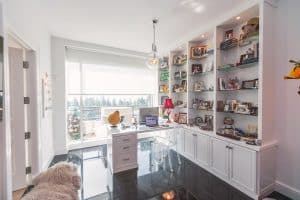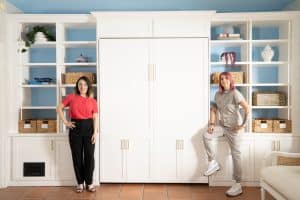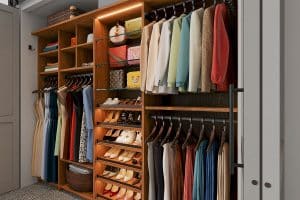Schedule a Free Consult
Schedule Your
Free Design Consultation
Free Design Consultation
In Part 1 we talked about the different DIY options that are available and the roles that they fill in the closet space. We discussed the quality of materials and construction methods, and made two important notes which we want you to keep in mind for Part 2: DIY systems have limited customizability due to inherent factors, and you will need the tools and skills to be able to install the system yourself.
Here in Part 2, we’re not going to talk about your physical ability – except when it comes to designing your closet! It’s time to talk about custom closets. We’re no longer worrying about how customizable the system is; from now on, you set the rules. We’re also moving into a different method of pricing, one which is substantially more flexible. Expect higher material and build quality and the certainty that you’ll love what you design.
 Custom closets do away with all the DIY elements, allowing you to focus your attention on the final product. Custom closet companies will assign you a designer who will work with you throughout the process and will have a team of professional installers put your custom closet in for you. This option is best for people who have a specific vision or those without an interest in picking up a nailgun.
Custom closets do away with all the DIY elements, allowing you to focus your attention on the final product. Custom closet companies will assign you a designer who will work with you throughout the process and will have a team of professional installers put your custom closet in for you. This option is best for people who have a specific vision or those without an interest in picking up a nailgun.
The other major difference between custom closets and DIY options is the way pricing works. Custom closets are priced based on you and your needs, rather than what’s packaged together. Even semi-custom options are substantially limited in what they can offer you in a way custom options aren’t. We’ll explore the way the Closet Factory design process works and how it influences the pricing.
Because Closet Factory custom closets are designed for those who will be using them, we don’t offer quotes until your designer has done their walk-through. This involves measuring the closet and working with you to select possible materials, features, and styles, at the end of which you will have a few possible designs and prices. It’s for this reason that we offer free, no obligation design appointments.
 As soon as your designer has measured the space you want transformed, they’ll be able to give you an estimate of the cost. Depending on the space, this estimate can be quite broad and possibly not all that helpful. That’s why most designers prefer to get the beginnings of a design down on paper before giving you a price estimate.
As soon as your designer has measured the space you want transformed, they’ll be able to give you an estimate of the cost. Depending on the space, this estimate can be quite broad and possibly not all that helpful. That’s why most designers prefer to get the beginnings of a design down on paper before giving you a price estimate.
Part of the design process is taking an inventory of everything you want to go into the closet once it’s finished. Your designer will keep this inventory in mind when designing the specifics of your closet, making sure to incorporate enough room for each needed storage type – including hanging, folding, and rolling.
Some elements of a custom closet have a decided influence on the cost. The material finishes you choose, the depth of the panels and shelves (how much reach-in you want), and the number of sections or divisions (how specifically organized you want to be) all affect price in broad strokes. The more material your design uses, the higher the cost. More sections means more panels and more storage, therefore more material. The arrangement of shelves and the addition of accessories like rods, drawers, doors, and cubbies will increase the price gradually,
Don’t be intimidated by the complexity of pricing! This is why your designer is there to work with you. You tell them what you want – style, function, feel – and your budget, and your designer will work with you to on possible designs. These will range from focusing on what’s important to day-to-day life, to grand and spectacular – meeting or exceeding every dream, and everything in between.
This process is why we encourage clients to be as up front as possible about their budget. Our designers are not salespeople; they’re looking for information to create the best possible custom closet for you. The result of keeping your budget close to your vest is a large number of rejected designs and a custom closet that could have been a bit more custom.
In Part 1 we discussed the benefits and limitations of DIY and semi-custom options, including their relatively low price and limited design choices – and the need for tools and skills to install them – before moving on to custom closets in Part 2, where we learned about the process of creating a custom closet and how that influences the cost.
Each of our custom closets is completely personalized and begins with a complimentary design appointment.
Schedule a ConsultDuring the consultation, you and the designer will discuss your decorative style, wish list, and project budget, with the aim of designing a closet organization system that will: